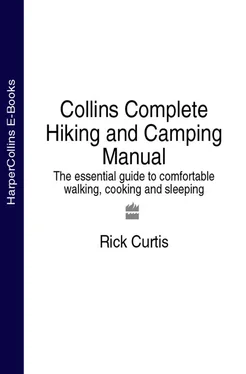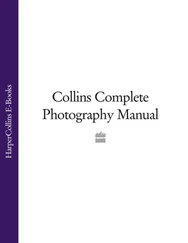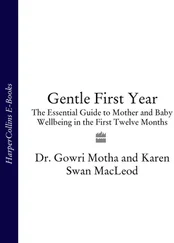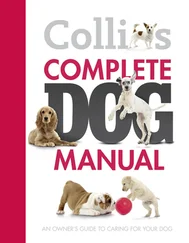
Packing External- and Internal-Frame Packs
Loading an Internal-Frame Pack
Your gear will help form the structure of support for an internal-frame pack. For easy, level hiking, a high center of gravity is best. To achieve this, load bulky, light gear (e.g., your sleeping bag) low in the pack and stack heavier gear on top of it. For steeper terrain, a lower center of gravity is best because it lessens the chance of falls from a top-heavy pack. In this case, place heavier items a little lower in the pack and closer to your back than normal. Women may prefer this arrangement under all circumstances.
GENERAL PACKING SUGGESTIONS
Stuff your clothes into the pack or pack items in stuff sacks rather than fold them. This serves to fill all the available space of the pack better so that things don’t shift around and allows you to get more into the pack.
The more common weight distribution (general trail hiking) has the lighter, bulkier items on the bottom: the sleeping bag and clothes. The heavier items such as food, stoves, and fuel go into the upper section or on top of the pack, with the heaviest items closest to the pack frame. A general rule is that 50 percent of the weight should be in the upper third of the pack.
For consistently steep or rough terrain, carry the weight lower to give you better balance.
The horizontal weight distribution should be balanced so that the left side of the pack is in balance with the right.
Your hip belt should have enough room to allow you to loosen or tighten it for different layers of clothing beneath. If the belt is too loose, socks or shirts can be inserted between the belt and your body. This adds an extra layer of padding to the belt as well, which may increase the comfort of the fit.
Avoid hanging things all over the outside of your pack—no one wants to listen to you clank and clang your way down the trail; also, all that junk can snag branches. If you find yourself having to tie things on all the time, either your pack is too small or you are carrying too much (or both).
Think about the things you will need during the day and have them relatively accessible so that it doesn’t take a complete emptying of your pack to find lunch, the first-aid kit, or your rain gear. Also, group and store items according to function. For example, keep toiletries together. Small stuff sacks help organize your gear.
For protection from rain, line your sleeping bag stuff sack and main pack compartments with plastic rubbish bags. These can be reused on subsequent trips and recycled when you are through with them. They also work as emergency shelters. Pack rain covers are also useful.
Fuel bottles should be placed below any food items or in pockets on the outside of your pack.
How Much Weight?
How much weight to carry depends on your size, weight, and physical condition. The general rule for a multiday backpacking trip is to carry no more than 15 to 25 percent of your body weight. On longer expeditions or trips with more gear (such as winter camping), this figure may go up. The bottom line is, don’t carry more than you need or more than you can handle. Many a hiker has blown out knees, ankles, or back by hauling more weight than she could handle. Here are some things to do to make your trip as comfortable as possible:
Try on your loaded pack at home before you leave.
Fiddle with the pack and adjust it at home (you probably won’t take the time to do this at the trailhead while your friends are waiting).
Weigh your pack and compare that to your body weight. Figure out the percent of your body weight that you are carrying. Is it too much?
Take a good look at what you are bringing. Prune out any odd nonessentials.
Look and see what other people are carrying and how the whole group can share the load in a way that makes sense for each member, given size, weight, physical condition, and experience.
Checking Your Pack Before a Trip
Take a look at the shoulder straps, hip belt, and other compression and load-carrying straps.
Check all pack buckles.
Check all zippers.
Check the pack bag itself for rips or tears.
If the pack is an external-frame pack with a pack bag mounted onto the frame, check the attachment pins (typically clevis pins and split rings).
Putting on a Heavy Pack
There are a number of methods for putting on a heavy pack to avoid straining.
1 With the pack on the ground and the shoulder straps facing you, lift the pack up and rest it on one extended knee. Slide one arm through a shoulder strap. At this point, your shoulders will be slightly tilted, so that the shoulder strap is sliding onto your shoulder toward your neck. Lean forward slightly and rotate your body to swing the pack onto your back. Slide your other arm through the other shoulder strap. Adjust the hip belt first. The easiest way to do this is to bend over at the waist so the weight is being carried on your back rather than your hips and the hip belt is free to be snugged up tightly. Then you can straighten up and adjust the shoulder straps. Aim for 70 to 80 percent of the weight on your hips.
2 Follow the same technique with a friend to help stabilize your pack. This is especially helpful if you are carrying a large or very heavy pack.
3 Lift the pack up onto an object that is about waist high (rock, log). Stabilize the pack and slip your arms through both shoulder straps. Pull on the pack and tighten the hip belt.
Putting on a Pack
I don’t recommend putting your pack on while sitting on the ground and then trying to stand up. This can place too much strain on your lower back. Instead, ask a friend (or two) to pull you up.
SLEEPING EQUIPMENT
SLEEPING BAGS
When selecting a sleeping bag, you need to consider a number of factors. Unlike clothing layers, a sleeping bag doesn’t offer much in the way of ventilation to control your body temperature. As a result, you might have more than one bag: a summer-rated bag for hot conditions, a three-season bag for spring and fall, and a winter bag for serious cold-weather conditions.
Sleeping Bag Temperature Ratings
Sleeping bags come with temperature ratings to give you a general idea of how cold it can get and if the bag will still provide adequate insulation to keep you warm. These ratings are averages and should be used only as guidelines. Some people sleep “colder” than others, so you may need a bag with more or less insulation to be comfortable at a particular temperature. Also, ratings differ from manufacturer to manufacturer. To calculate the temperature rating you will need, look at the lowest normal temperature for the trip location and season you are going, and then subtract 10° or 15°F (9° or 12°C) from that temperature. This gives you a margin of safety in case the temperature is colder than expected. For example, if the usual nighttime temperature is 50°F (10°C), bring a bag that goes to about 35°F (2°C). Here are some general guidelines for sleeping bag ratings:
| Season |
Temperature Rating |
| Summer |
40° to 60°F (4° to 16°C) |
| Three-season |
20° to 40°F (–6° to 4°C) |
| Cold-weather |
0° to 20°F (–17° to –6°C) |
| Winter |
–30° to 0°F (–34° to –17°C) |
Sleeping Bag Styles
The following are three general styles for sleeping bags:
Mummy A form-fitting bag with a hood. The bag tapers in width from the shoulders to the legs, with little room. This snug fit means that there is less convective heat loss in the bag, making for a warmer bag. Mummy bags use less fill than comparable rectangular bags and will weigh less.
Читать дальше













